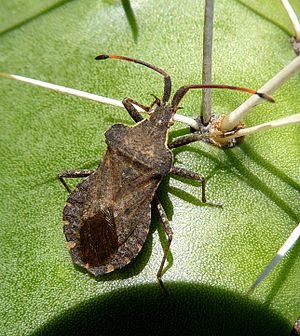Enoplops scapha
| Enoplops scapha | ||||||||||||
|---|---|---|---|---|---|---|---|---|---|---|---|---|

Enoplops scapha |
||||||||||||
| Systematics | ||||||||||||
|
||||||||||||
| Scientific name | ||||||||||||
| Enoplops scapha | ||||||||||||
| ( Fabricius , 1794) |

Enoplops scapha is a bug from the family of the edge bugs (Coreidae).
features
The bugs are 11 to 13 millimeters long. They are characteristically dark gray in color and have cream-colored spots on the connexive . Young nymphs have very thorny antennae and a green colored abdomen. At first glance, older nymphs resemble leather bugs ( Coreus marginatus ), but have more pointed tergites on their abdomen.
distribution and habitat
The species is distributed in the Palearctic . It occurs everywhere in Germany and is not uncommon south of the low mountain range threshold, but only sporadically documented in the northern lowlands. The species is widespread in Austria. You can find them in the Alps up to about 1300 meters above sea level. In Great Britain the species is predominantly distributed only on the coasts between Kent and the north of Wales and occurs only locally. Dry to slightly damp, open habitats are colonized.
Way of life
The animals are bound to the predatory family (Boraginaceae), in particular to dog tongues ( Cynoglossum ), viper heads ( Echium ), solder roots ( Onosma ) and comfrey ( Symphytum ). They suck on the leaf tissue and above all on the ripening fruits. As with the leather bug, the younger nymphs are bound to a certain host plant, while older nymphs and adults can also be found on herbaceous plants from other families, such as camomiles ( Matricaria ), ragweeds ( Senecio ), thistles ( Cirsium ), knapweeds ( Centaurea) ) and Artemisia from the daisy family (Asteraceae), carrots ( Daucus ) from the umbelliferae family (Apiaceae), thyme ( thymus ) and sage ( Salvia ) from the mint family (Lamiaceae) and mullein ( Verbascum ) from the family the figwort family (Scrophulariaceae). Mating and oviposition takes place in May and June. The females lay their eggs on the basal leaves of the food plants. The nymphs appear from June and can be found until August or September. The adult animals of the new generation can be found from the end of July. The overwintering, for example under the rosette leaves of mullein, sometimes takes place in aggregations.
supporting documents
Individual evidence
- ↑ a b c d Wachmann: Wanzen , Vol. 3, p. 208
- ↑ a b Enoplops scapha. British Bugs, accessed June 21, 2014 .
literature
- Ekkehard Wachmann , Albert Melber, Jürgen Deckert: Bugs. Volume 3: Pentatomomorpha I: Aradoidea (bark bugs), Lygaeoidea (ground bugs, etc.), Pyrrhocoroidea (fire bugs) and Coreoidea (edge bugs, etc.). (= The animal world of Germany and the adjacent parts of the sea according to their characteristics and their way of life . 78th part). Goecke & Evers, Keltern 2007, ISBN 978-3-937783-29-1 .
Web links
- Enoplops scapha at Fauna Europaea. Retrieved June 21, 2014